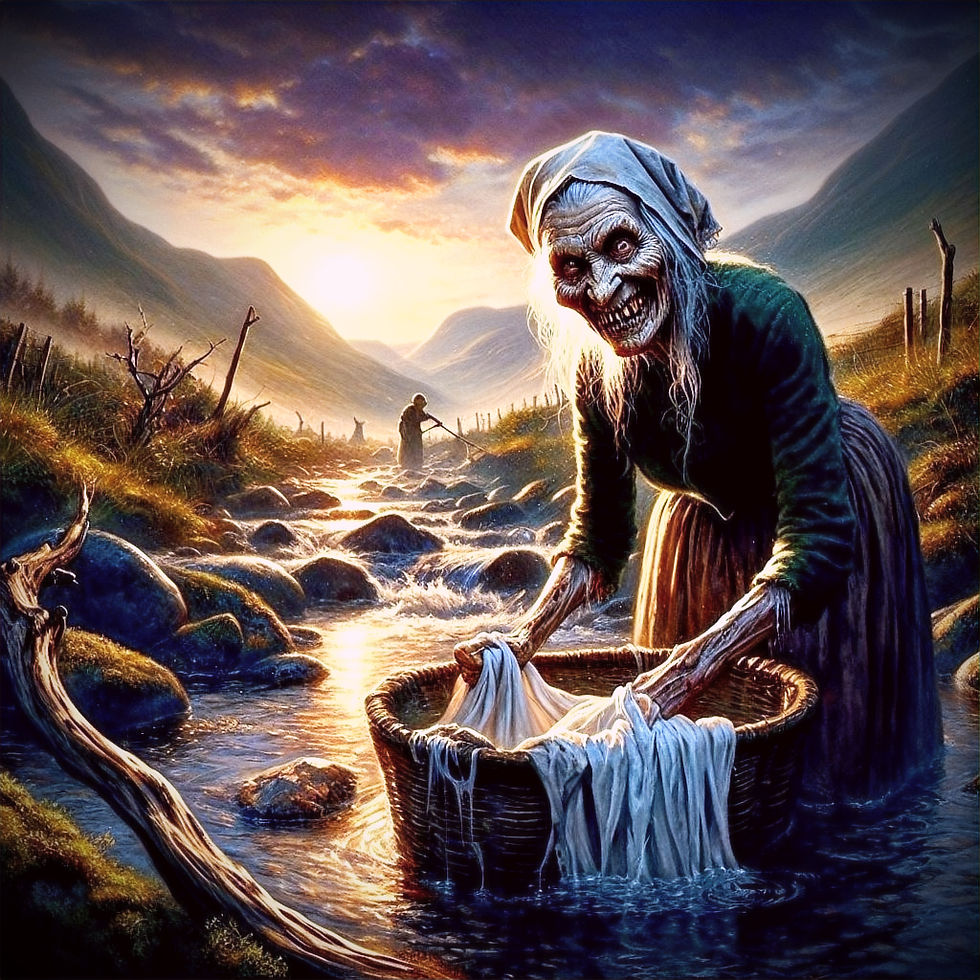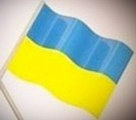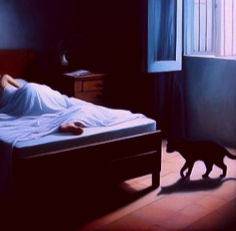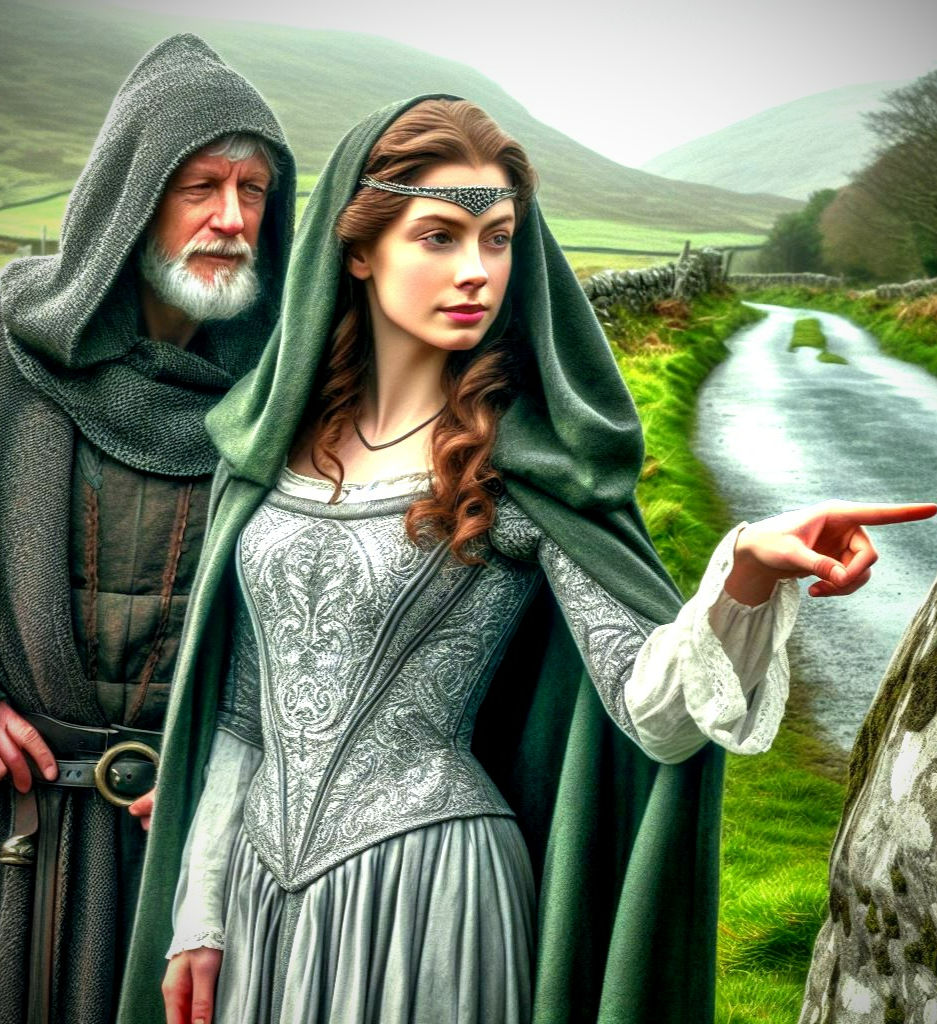Scary Faeries of Celtic Folklore
- Christine Dorman

- Sep 4
- 8 min read

Autumn’s on its way! (According to the Celtic calendar, it arrived back on August 1st!) Fall is my favorite season. I love the chill in the air, the warm spices, the autumnal colors, and all the harvest-related decorations. Autumn, most of all, puts me in mind of Halloween and Samhain. So, in anticipation of those holidays, let’s talk scary faeries.
Murderers
Redcaps: Redcaps got their name from their practice of dying their caps in the blood of their victims. If that doesn’t give you a heads up to steer clear of these guys, I despair of you. So, how can you avoid them? Fortunately, they’re fairly predictable. Redcaps tend to hang out in or near castle ruins on the border between Scotland and England. So, if you see a ruined castle near the border…. I trust you can finish that sentence. I hate to be a killjoy, but I’d recommend being cautious around Hadrian’s Wall, too.
Here’s a description of these vile creatures. They look like bearded old men, small in stature, booted, and carrying a pike in their left hands. Sources classify Redcaps variously as dwarves, goblins, or faeries. I’m putting them in the faerie category. Here’s why: Dwarves are from the Norse folklore tradition, not the Celtic. Goblins are classified as a type of sprite. Sprites are faeries. So, it’s reasonable to include Redcaps in a discussion of scary faeries.
Are they faeries or not? You decide. Just stay far away from them!
Ceffyl Dŵr: In Welsh, ceffyl dŵr means “water horse.” If you’ve been reading my posts for a while, you know Celtic water horses are bad news. The most famous of these Celtic faeries are the Scottish Kelpies. These shapeshifters often hang out around Scottish lochs and rivers, waiting for human prey. Although they sometimes take on human form, they usually appear as either a horse or a pony, encouraging humans to mount them. Once on, the human is unable to get off. The Kelpie runs into the water and drowns its victim. Then the faerie feasts on the human.
It’s not a nice thing to do. But humans also kill other living beings then eat them.

The Welsh Ceffyl Dŵr is similar to a Kelpie but more sinister. A shapeshifter as well, it also usually presents as a horse, often winged, and sometimes luminous. It is known to ride humans into the water in kelpie-like fashion. Also, this faerie horse will rise up suddenly out of the water to attack humans. But one of its favorite pastimes is to fly the human high into the sky. Once the Ceffyl Dŵr reaches the apex of its arc, it vanishes, leaving the human to fall to his or her death. Why? Not for food. Just for kicks.
Malignancies
Joint Eater: This faerie is so tiny it can crawl into your ear while you’re sleeping. But this only occurs if you fall asleep next to water. So, be careful not to do that! What happens if you goof and take a nap next to a peaceful loch? Once a joint-eater gets inside you, it takes up residence, sustaining itself on every speck of nutrients you take in. While this parasite remains in you, you will waste away no matter how much food you consume.
But there is hope. You can get rid of a joint-eater by returning to the loch and lying down again. Stay awake! But, if you lie very still, and the joint-eater may crawl out of you to return to the water. I’m not making any guarantees, but folklore says this often works. Once the little bugger is out of you, get away from the loch. Quickly.
Leannan Sidhe: Oh, a thing of beauty is sometimes deadly. The term leannan sidhe, in Irish, means “faerie lover.” And this lover has a type. She likes artists, especially poets. She will come to them in all her irresistible beauty and act as the artist’s muse. As a result, the human will create great art. But at a great price.
The artist falls hopelessly, obsessively, in love with this faerie, but that’s a mistake. She will desert him frequently, leaving him in despair and unable to create until she returns. Which she will. But this is an on-going pattern that tortures the artist and sucks the life out of him. Invariably, the artist dies, still yearning for her.
Messengers of Death

Bean Nighe: Similar to the Irish banshee, the Scottish Bean Nighe warns of death. She always appears as an old hag washing bloody clothes in a stream. If they’re your clothes, the warning is for you. She beats the clothes with a stick and, if you get too close to her, she’ll hit you with the stick. As a result, whatever part of your body is hit will be paralyzed.
Banshee: Neither ghosts nor the predatory, homicidal monsters that the American entertainment and online gaming industry depict them to be, Irish banshees are faerie women who adopt and watch over a human family. Their main ministry is to warn the family of an imminent death of one of its members. They do this by wailing (not screaming or screeching).
Banshees appear in one of three forms. They may look like the stereotypical old hag they’re often depicted as, but they also often appear to be middle-aged noblewomen of dignified beauty. Finally, they’ve been reported to look like young women of exquisite beauty who are inconsolably sad. Usually, their hair is long and dark. Their eyes are grey, red-ringed, and swollen from crying. Banshees are compassionate and are known to do magical favors for the families they watch over. So why are they scary? They are messengers of death.
Caointeach: Similarly, the Scottish Caointeach (or the Weeper) is not out to harm humans. She sings a heart-rending lament near streams or waterfalls. Often, she remains unseen to human eyes. Only her sorrowful song is heard. However, she sometimes appears outside the house where a sick person lies. At those times, she takes on a visible form, wearing a green shawl, and crying at the door of the house. While neither malevolent nor scary in herself, she is a folklore character you never want to encounter because her presence means one thing: death is near.
Curiad: Okay. Who could be afraid of a beaver? Well, wait. This Welsh faerie resembles a gigantic beaver. It appears at your home when someone is in danger of dying. The faerie remains outside, warning you by beating its tail to a steady rhythm until the person either gets better or dies.

The Dullahan: The Dullahan is one of the scariest faeries in Irish folklore. A combination of the Grim Reaper and the Headless Horseman, this faerie, caped and dressed all in black, carries his glowing head like a lantern. He rides a dark horse that snorts flames and spurs the horse on with a whip made of a human spine. It is said that wherever the Dullahan stops, someone dies.
Soul Stealers
Cat Sith: Looking like a Halloween cat—black, eyes glowing, back arched, tail up, hair on end—this Scottish faerie’s favorite pastime is to go into bedrooms where someone who has just died is laid out for a wake. The faerie walks over the corpse to steal away the person’s soul.
Irish folklore’s similar faerie, the Cat Sidhe, is nowhere near as nasty. It goes from house to house on Samhain, looking for a bowl of cream. If one is left on the porch, the faerie will bless the family with all sorts of good things. If, however, they have neglected to leave a gift for the faerie, the Cat Sidhe will curse them with lifelong misery and misfortune. Which is not good, but it’s better than stealing your soul.
Sluagh Sidhe: This collective is among the scariest and most dangerous of Irish faeries. They look like something out of a nightmare, human in form but skeletal, with only a bit of flesh dangling from their bones. A few strands of dark hair hang from their skulls. Their beak-like mouths have protruding and pointed teeth. Their hands and feet are nothing more than bony claws. The Sluagh Sidhe are among the few Irish Faeries with wings, but their wings are not beautiful. Instead, they are leathery, bat-like wings that resemble a cloak when they’re held close to the body.
On Samhain’s Eve, this faerie collective flies out of Hell Gate in the western province of Connacht. Soaring into the human realm, looking like a flock of crows against the sky, they spend the night ruining crops, killing cattle, sheep, dogs, and cats. They also carry off humans who are out traveling alone in the dark.

But the Sluagh Sidhe are not a danger just on Halloween. Throughout the year, they search for souls. Folklore claims they will fly in through open, west-facing windows of sickrooms and anywhere a human lies dying. They steal the souls of those weakened by illness and especially those who’ve died without receiving last rites.
Mischievous to Malevolent
The Puca: The Puca is found across Celtic folklore. Often, he’s depicted as a mischievous prankster. But some stories paint him as malevolent. He might be both. Remember: Irish faeries are capricious.
Although he often appears as a black horse with golden eyes and a long mane, the Puca is a shapeshifter and takes any form. But even when he appears human, he usually has an animal attribute of some kind, such as cat ears or a bunny tail.
He sometimes helps humans he likes, offering them wisdom or advice. But he also enjoys giving incorrect directions to travelers just so he can sit back and watch them get lost and confused. I said he could be mischievous. However, the Puca has a darker side.
The Puca is known to stop at a person’s house and call the person by name. If that person does not come out, the faerie will respond vindictively, destroying the property. He’s also been known to sneak up behind travelers at night and throw them into bogs and ditches.
Not to be Messed With
Bodach: A bringer of nightmares, the Bodach comes down chimneys and preys on little children. He’s also been known to steal human children, putting a changeling in their place.

Blackthorn Moon Faeries: Blackthorn trees are guarded by moon faeries. They are highly protective of their trees and hostile to humans in the best of times. But they are particularly ferocious towards humans who disturb their trees at Samhain and on Beltane. Since being pierced by a blackthorn’s prickle can be toxic and cause a festering wound. My advice is to enjoy these trees from a distance!
The Morrigan: All right. I’m cheating here. But, if we’re going to talk about terrifying Irish folklore characters, the Morrigan needs to be included. She is not a faerie. She is a goddess.
Typically, she is depicted as young, beautiful, and dark-haired, usually dressed in black, with the hood partially obscuring her face. However, she’s a shapeshifter who can appear anyway she wants. The Morrigan’s favorite form to shift into is that of a crow or a raven. A goddess of war and fate (among other things), she enjoys soaring above battles, watching the show, helping those she likes, and bringing death to those she chooses to destroy. Morgan le Faye, of Arthurian legend fame, is said to have been based on this Irish goddess.
Thanks for reading! I hope you enjoyed this post and any of my others you check out. Please LIKE and SHARE. To SUBSCRIBE for FREE, just click on the “Sign Up” button in the upper right of the page.
All artwork for this post (except for the Ukranian flag and the GIF) by Christine Dorman via Bing Image Creator.
Slán go fóill
Looking for a guide along your writing journey? Click here for a description of my writing and tutoring services. Questions? Just click here to contact me.





Comments